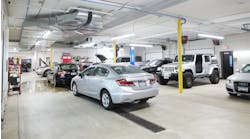The answers to these questions are of extraordinary importance to anyone in the automotive repair industry, in particular to the many small independent shops out there that are trying to compete as fairly small fish in a very large pond and survive in a marketplace that is challenging, ever changing and very complex. Telematics in a broad definition is simply wireless communication with a remote vehicle supporting a variety of applications that might include such items as satellite navigation, vehicle diagnostics, vehicle tracking (that would include the ability to monitor driver behavior), integration with the internet and social media and all that goes with that. In other words, telematics is or soon will be converting our cars into oversized, physically mobile smart phones. Telematics have the potential to reshape how the aftermarket engages and interacts with our customers and potential customers but only if we gain access to this emerging arena and only if we challenge the Original Equipment Manufacturers (OEMs) and the new car dealerships for our share of this growing market. The very good news is that there are a good number of emerging and viable telematics providers; the bad news is that the Automotive Aftermarket has been somewhat slow on the uptake and is far behind.
Automotive fleets (delivery trucks, buses, public safety) have long sought ways to monitor both drivers and vehicles remotely. Insurance companies have long sought ways of monitoring the habits (braking, speed, and attention to traffic laws) of drivers, rewarding good behaviors with low insurance rates and penalizing bad behaviors with higher rates. Enforcement for a long time was reactive, often not possible until an incident brought the behavior to the forefront. With telematics, both insurance companies and fleet operators are able to continuously monitor driver habits and actions and manage and adapt accordingly.
In a recent conversation John Cave the Telematics Operations Manager at Element Fleet Management said, “Utilizing telematics to improve fleet utilization can provide significant savings by reducing vehicle idling, fuel spend and overall maintenance costs. The benefits of telematics also complement an organization’s social responsibility goals and initiatives. Understanding how fleet vehicles are used by the organization through the use of telematics can allow companies to right size their fleet. Rightsizing vehicle fleets will reduce the corporate carbon footprint. Fewer vehicles on the road mean less waste, less impact on the environment, and an improved total cost of ownership. For some organizations, the upfront cost of telematics can seem like a roadblock or insurmountable investment. It’s important to not lose sight of the return on investment that includes cost reductions, improved safety and enhanced corporate social responsibility. Organizations have a responsibility to ensure that their drivers are safe and are operating vehicles in the best interest of the business. Driver behavior and productivity become easier to manage through telematics. Vehicle use can be monitored, allowing for route optimization, best possible time management, and cost effectiveness. Speeding, harsh driving, and other driver misbehaviors can now be monitored and coached effectively.”
John went on to say, “Organizations have a responsibility for driver safety, both for the driver and for the public with whom they interact. Improving driver behavior can also assist with lowering auto insurance premiums by up to 15 percent.”
Both fleets and the insurance industry are heavily involved in telematics and have been for many years but most recently consumer demand (probably those darn Millenials again!) is driving innovation and the development of this technology at an unprecedented rate and turning our cars into extensions of our smart phones and all the function and capability that goes with that. Cars are not only smarter than ever, they are also more interactive than ever and this is both a risk and a huge opportunity to the automotive aftermarket.
Some of the players in this emerging market are familiar to us but this is a sector of the automotive world that is still sorting itself out and as consumer interest and innovation increase, there is still a lot of shaking out going on. One thing is sure, competition is keen and just like has been seen with our smart phones, when the American consumer grabs hold of something, the opportunities can be huge. Our choice in the aftermarket is either to embrace and go after these opportunities or concede the opportunity that telematics represents to the dealer. My very strong hope would be for our embracing this opportunity, not just for our industry but for the millions of customers we of the aftermarket represent. There is no doubt that the OEMs and new car dealers do a lot of things very well but providing a caring customer experience is not always one of them and conceding telematics to the dealers gives consumers far fewer choices, far less convenience and makes them more dependent on the dealer than they have ever been. Giving consumers (our customers and would be customers) choices is an important part of what we do in the aftermarket and even though the dealers are ahead of the aftermarket and have the very direct support of the OEMs, my strong preference is that we fight them tooth and nail for the huge and still growing opportunity that telematics represents. Our customers are more than deserving of that effort.
At its very best telematics allows the independent shop to compete with the dealerships and OEM telematics by providing them with the ability to perform remote diagnostics, diagnostics that includes all modules and functions. Warning lights and notifications can be cleared remotely and reset; enhanced data can be read, analyzed and recorded. Along with this, most of these systems are tied to the internet, social media, with all of the marketing options and opportunities that go with that. As a check engine light illuminates on a customer's car, our repair shops will have the ability to reach out and touch those customers, helping them understand what the light means and helping them arrange appropriate remedial action. Above and beyond repairs, telematics represent a huge step forward in customer engagement and interaction. When a service is due we are instantly aware and can quietly send reminders and remotely set up appointments for our customers. Obviously we have to be sensitive to our customers and not hound them into submission but telematics gives us of the automotive aftermarket unprecedented opportunity to engage and hopefully exceed our customers’ expectations for customer service.
Though there is any number of existing and emerging telematics providers out there, a few of the more serious players are Launch Tech USA and their GOLO device (available on Amazon.com), Delphi Product and Service Solutions, Verizon's 'In Drive' and Airbiquity's Choreo platform. Just like our smart phones, all of these devices are incredibly robust and capable, and just like our smart phones; all of these devices and platforms, with their telematics capabilities have the potential to transform how we run our shops, how we go to market and how we interact with our customers. Telematics are here to stay and the only question is whether you will jump on that train and have it take you wherever it would go or you will let it pass you by. My vote is us getting on board!
That connected car out in our third bay is ringing. Maybe we as an industry need to answer it.


